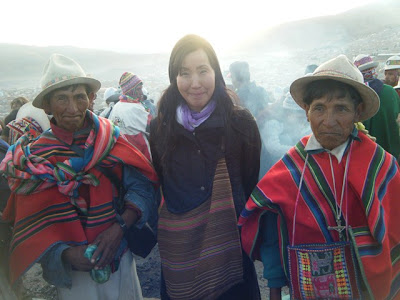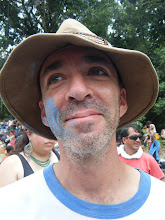Editor's Note #2 - WARNING! This post contains graphic images of dead llamas killed for ritual purposes and for food. Though if you eat meat, wear leather shoes, feed your cat or use a down blanket then this really shouldn't bother you, now should it.
So we do our mining tour on Tuesday and could pretty much leave Potosi and then we hear about the upcoming miners fiesta. On the final three Saturdays in June the miners of Potosi sacrifice llamas. I do not know an exact reason for them doing this, but I believe it is connected to ensuring the safety of the workers. Miners are very superstitious and they want the llamas blood to satisfy El Tio, the demon/deity of the mines. Yet this festival is also for Pachamama - Mother Earth. Throughout the day we are leaving her offerings and the llamas final remains will eventually be buried in her bowels. This event will be happening in front of every mine entrance at Cerro Rico and with every cooperative of miners performing their own ritual.
 |
| Mine Entrance |
At nine in the morning a large group gathers at our hostel, which is fun, but I am a bit worried about having a big gang of gringos crashing a fiesta. We first walk to the Miners Market to buy beer and coca leaves and to catch the bus to Cerro Rico, the mining mountain. We have some time so our Bolivian guides tell us that we can walk up the hill to check out where they are selling the llamas tethered to light poles and loading them into trucks. Right away I can tell that it will be a good day. The miners are in good spirits, smiling, chatting with us and shaking hands.
 |
| Guests of honor - unwittingly |
A jeep arrives carrying the miners and loaded down with beer bottles. We are kindly accepted into their group and honor this moment with a can of beer, a shot of their homemade cocktail of orange drink and Whiskey Boliviano - 96% cane alcohol and preferred drink of the miners - and a handful of coca leaves. I actually had not planned on drinking today, and it is still before 11:00 AM, but I can easily see that avoiding alcohol will be impossible. Miners like to drink and they are very good at it. The beer and Devil's Cocktail keep flowing until we depart around 6:00 PM while the miners kindness and generosity to share with us never ceases for a moment. This is not just with alcohol. I also said that I am not going to chew coca leaves today. I bought a bag in the market to share with people, but they are also sharing their stashes with me.
| Sharing coca leaves |
We are also handed cups of beer and instructed by the miners to pour it on the llamas as another type of offering. This is done when the llamas are alive and dead. The four llamas are eventually pulled in front of the mine entrance which we all know is where the deed will be done, but there is still some build up. Next we wait pouring more beer on the llamas. Then the beasts are force fed beer and coca leaves - more offerings.
Meanwhile, more gringos have descended on this fiesta. It is actually amusing because they are coming from their mining tours, so they are the ones dressed as miners for a miners party. So it is a pretty large, festive group of gringos, guides and miners when the moment of truth arrives.
 |
| Moving the llamas to the mine entrance |
| Feeding llama beer |
Three men hold down the llama while the man with the knife has his knee on the neck. This is the one part that bothers me: their knives are two small to kill the llamas quickly. He slices through the neck. The blood spurting from the neck is collected in bowls. He then moves to the next one until all four have been killed. From a foreigner's perspective it is very easy to lament the poor llamas brutal death, but they are part of a tradition much bigger than us and our Western sensibilities. It is by no means pleasant to watch, but would it be less humane than what is happening at any slaughterhouse in North America or Europe? I kind of doubt it.
This is the now the first time that we see women. The ladies retrieve the bowls of blood. One woman throws fresh blood onto the mine entrance while another sprays bottles of beer. I heard that at some places the blood is put on the faces of the miners and guests, but it is not done here. Four bowls are used to make another offering inside.
| Everyone who entered this room spilled some alcohol on each corner of this offering for Pachamama |
 |
| Time to butcher the llamas and most tourists are keeping their distance |
 |
| While others prefer the hands-on approach |
 |
| This is to be buried later for Pachamama |
 |
| "Hey, no playing with Pachamama's llama parts!" |
 |
| Ladies grilling the llama meat |
 |
| My herbivore teeth are no good at tearing meat |
The Rambler's Rant
When reading writings about the mining tour in Potosi I see enough people questioning the ethics of doing the mine tour or saying how sad it is. Do the miners benefit from the tours? How can we take photos of people working in appalling conditions? Basically, it is first world tourists feeling guilty about going to see the poor developing world laborers as they toil away for paltry wages. To me these arguments are a crock of... well, llama poop.
Children are one thing. There should be absolutely no one under eighteen working in the mines and to see them doing so must be heart-breaking. But I am talking here about the adult miners who earn little wages risking their lives and long-term health in the hopes of striking it rich for themselves and their families. In the documentary film, The Devil’s Miner, the boy says that he is embarrassed to tell his classmates that he is a miner. Our guide, an ex-miner, told us that this part of the film made them very angry. The men who work in the mines of Potosi are proud and strong. The last thing that they want is people’s pity - especially from a bunch of gooey gringos who make it all the way to Bolivia without stepping outside of their insulated bubbles.
Maybe I am lucky. I had a whole afternoon at the fiesta to hang out and talk with the miners on a personal level. Drinking beer and having a laugh with the boss or being able to hear one guy’s story about how he overcame drug addiction and can now support his young family by working in the mines definitely broke the superficiality usually found on mine tours. I cannot reiterate enough how kind and generous these guys were to us. Not one of them asked for our sympathy and as visitors to their world this is something we should all respect.
So my recommendations for anyone considering doing the mine tours. First of all, if you think that you will feel guilty or sad and need to blog about your feelings afterwards then don’t go. It is disrespectful to these proud miners and does everyone a disservice, including yourself. Secondly, find a tour company that gives good opportunities to miners and their families. Ask if your guide worked in the mines. Our company, The Real Deal, was owned and run by ex-miners and I am sure there are others. Lastly, when in the mines give the people you meet gifts which they can use, take photos and speak with them on a human level, not as a tourist attraction, and sincerely thank them for giving you the opportunity to see them work. Just leave your pity at home.











































